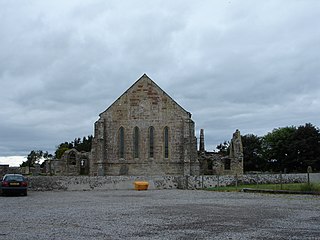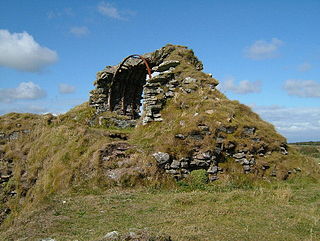See also
Senior churchmen of Medieval Scotland (post-1100) | |
|---|---|
| Archbishops | |
| Bishops | |
| Archdeacons | |
| Abbots | |
| Priors | |
The Prior of Whithorn was the head of the monastic community at Whithorn Priory, attached to the bishopric of Galloway at Whithorn. It was originally an Augustinian establishment, but became Premonstratensian by the time of the second or third known prior. As most of the priors of Whithorn appear to be native Galwegian Gaels, it would appear that most priors before the 16th century at least were drawn from region, something unusual in medieval Scotland. The following is a list of abbots and commendators.
James Beaton (1473–1539) was a Roman Catholic Scottish church leader, the uncle of David Cardinal Beaton and the Keeper of the Great Seal of Scotland.

Dundrennan Abbey, in Dundrennan, Scotland, near to Kirkcudbright, was a Cistercian monastery in the Romanesque architectural style, established in 1142 by Fergus of Galloway, King David I of Scotland (1124–53), and monks from Rievaulx Abbey. Though extensively ruined, Dundrennan is noted for the purity and restraint of its architecture, reflecting the austere Cistercian ideal. It is also built from very hard-weathering grey sandstone, so the original architectural forms and mouldings are well preserved.

Whithorn Priory was a medieval Scottish monastery that also served as a cathedral, located at 6 Bruce Street in Whithorn, Wigtownshire, Dumfries and Galloway.

The Abbot and then Commendator of Melrose was the head of the monastic community of Melrose Abbey, in Melrose in the Borders region of Scotland. The abbots of the earlier Northumbrian foundation from Lindisfarne are not included here. The second abbey was founded in 1136 on the patronage of David I, King of Scots, by Cistercian monks from Rievaulx Abbey, Yorkshire. Control of the abbey was secularized in the 16th century and after the accession of James Stewart, the abbey was held by commendators. The last commendator, James Douglas of Lochleven, resigned the abbacy to William Douglas, 6th Earl of Morton in December 1606, and the abbey itself to the king in 1608. The abbey was then erected into a secular lordship for viscount Haddington, John Ramsay, who in 1609 was created "Lord Melrose". Lochleven however resumed the title of commendator in 1613 until his death in 1620.

The Prior, then Abbot and then Commendator of Dunfermline was the head of the Benedictine monastic community of Dunfermline Abbey, Fife, Scotland. The abbey itself was founded in 1128 by King David I of Scotland, but was of earlier origin. King Máel Coluim mac Donnchada had founded a church there with the help of Benedictines from Canterbury. Monks had been sent there in the reign of Étgar mac Maíl Choluim and Anselm had sent a letter requesting that Étgar's brother and successor King Alaxandair mac Maíl Coluim protect these monks. By 1120, when Alaxandair sent a delegation to Canterbury to secure Eadmer for the bishopric of St Andrews, there is a Prior of the Dunfermline monks by the name of Peter leading the delegation. Control of the abbey was secularized in the 16th century and after the accession of James Stewart in 1500, the abbey was held by commendators. In the second half of the 16th century, the abbey's lands were being carved up into lordships and it was finally annexed to the crown in July, 1593.

The Abbot of Arbroath or Abbot of Aberbrothok was the head of the Tironensian Benedictine monastic community of Arbroath Abbey, Angus, Scotland, founded under the patronage of King William of Scotland from Kelso Abbey and dedicated to St Thomas of Canterbury, Thomas Becket. The abbot, John Gedy, was granted the mitre on 26 June 1396. Arbroath Abbey became the wealthiest and most powerful abbey in later medieval Scotland.
The Abbot of Dundrennan was the head of the Cistercian monastic community of Dundrennan Abbey, Galloway. It was founded by Fergus of Galloway in 1142. Dundrennan was a large and powerful monastery in the context of the south-west. It became secularised and protestantised in the 16th century. In 1606 it was finally turned into a secular lordship in for John Murray of Lochmaben, afterwards earl of Annandale.
The Abbot of Glenluce was the head of the monastic community of Glenluce Abbey, Galloway. The monastery was founded in 1192 by monks from Dundrennan Abbey with the patronage of Lochlann (Roland), Lord of Galloway. In the 16th century the monastery increasingly came under the control of secular warlords. In 1560 the monastery was occupied by James Gordon of Lochinvar, and the monks were expelled. However, soon after, Thomas Hay, a follower of the earl of Cassillis, was installed in the monastery as commendator and the monks were allowed to return. However, monastic life seems to have disappeared by the end of the century. In 1602 parliament granted the lands of the monastery to Lawrence Gordon as a secular lordship. The abbey was finally given to the bishop of Galloway in 1619. The following is a list of abbots and abbot-commendators:
The Abbot of Crossraguel was the leader of the Cluniac monastic community of Crossraguel Abbey, near Maybole in Carrick, south-west Scotland. It was founded in 1260s by Donnchadh mac Gille Brigte, earl of Carrick with monks from Paisley Abbey. Owing to the lack of surviving records and its distance from the core of Lowland Scotland in the western Gàidhealtachd, few of the abbots are known by name. The abbots were replaced by commendators in the 16th century, and the abbey came to an end when its lands were taken over by the bishops of Dunblane in 1617.

The Abbot of Fearn was the head of the Premonstratensian monastic community of Fearn Abbey, Easter Ross, Scotland. The Abbey was founded by canons from Whithorn Priory in Galloway, with the patronage of Fearchar mac an t-Sagairt, mormaer/earl of Ross. The foundation took place in the 1220s, according to the two distinct foundation dates given in the sources, either in 1221 or in 1227. Until about 1238, the Abbey was located at Fearn, near Edderton, but it was moved to the Tarbat parish in that year and known thereafter as "nova Furnia". Despite the fact that the head of Whithorn Priory was a prior and Fearn an abbot, Fearn seems to have remained subordinate to Whithorn until at least the end of the 14th century, and even in 1440 Abbot Fionnlagh II was confirmed by the prior of Whithorn.The reason for this is that Whithorn was a cathedral priory; the nominal head of its community was the bishop, but its actual head was the prior, as was the common use in England at places like Durham and Carlisle, but this was not usual in Scotland. In these circumstances the cathedral prior had the same rights as an ordinary abbot.
The Abbot of Holyrood was the head of the Augustinian monastic community of Holyrood Abbey, now in Edinburgh. The long history of the abbey came to a formal end in July 1606 when the parliament of Scotland turned the abbey into a secular lordship for the last commendator, John Bothwell. The following is a list of abbots and commendators:
The Abbot of Dercongal or Abbot of Holywood was the head of the Premonstratensian monastic community of Dercongal Abbey. The history of the abbots of the house is obscure and very few are known by name. The following is a list of abbots and commendators who are known:
The Abbot of Soulseat was the head of the Premonstratensian monastic community of Soulseat Abbey in Galloway. The following is a list of abbots and commendators:
The Abbot of Tongland was the head of the Premonstratensian monastic community of Tongland Abbey in the historical county of Kirkcudbrightshire in Dumfries and Galloway. The following is a list of abbots and commendators:

Gilbert was a 13th-century Cistercian monk, abbot and bishop. His first appearance in the sources occurs under the year 1233, for which year the Chronicle of Melrose reported that "Sir Gilbert, the abbot of Glenluce, resigned his office, in the chapter of Melrose; and there he made his profession". It is not clear why Gilbert really did resign the position of Abbot of Glenluce, head of Glenluce Abbey in Galloway, in order to become a mere brother at Melrose Abbey; nor is it clear for how long Gilbert had been abbot, though his latest known predecessor is attested last on 27 May 1222. After going to there, Gilbert became the Master of the Novices at Melrose.
Odo Ydonc was a 13th-century Premonstratensian prelate. The first recorded appearance of Odo was when he witnessed a charter by Donnchadh, Earl of Carrick, on 21 July 1225. In this document he is already Abbot of Dercongal, incidentally the first Abbot of Dercongal to appear on record.
Gavin Hamilton, bishop of Galloway, was the second son of John Hamilton of Orbiston, Lanarkshire. The father, descended from Sir James Hamilton of Cadzow, fell at the battle of Langside, fighting for Mary, Queen of Scots.

David Arnot was a Scottish prelate of the Catholic Church. He was the Bishop of Galloway (Scotland) from 1509 to 1526. He was from the Arnot family of Arnot, Fife.

Cruggleton Castle is a multi-period archaeological site on the coast of the Machars, in the historical county of Wigtownshire in south-west Scotland. It is located at Cruggleton Point, around 4.5 kilometres (2.8 mi) east of Whithorn and 6 kilometres (3.7 mi) south-east of Sorbie. Excavations in the 1970s and 1980s revealed several periods of use, from the 1st century AD to the 17th century. The first stone tower was built in the 13th century, on an earlier motte.